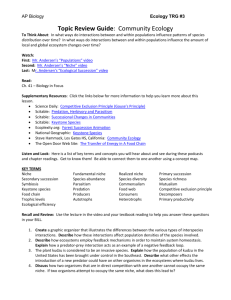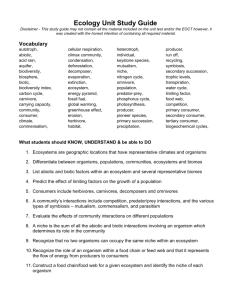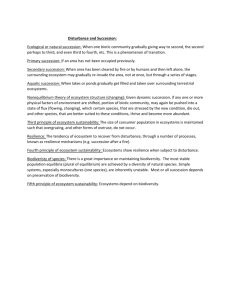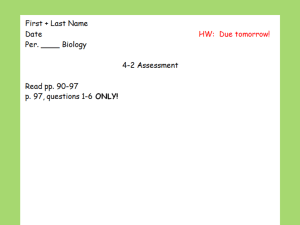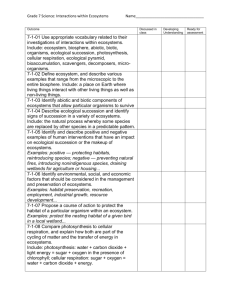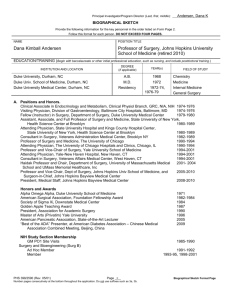trg community ecology - mhs
advertisement
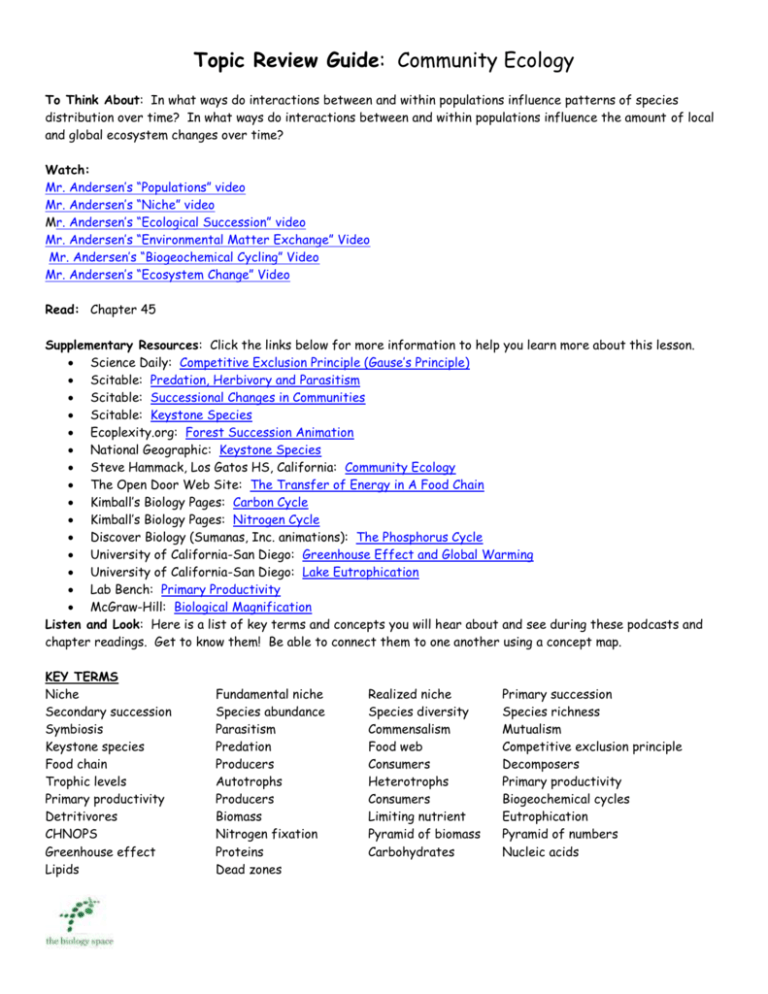
Topic Review Guide: Community Ecology To Think About: In what ways do interactions between and within populations influence patterns of species distribution over time? In what ways do interactions between and within populations influence the amount of local and global ecosystem changes over time? Watch: Mr. Andersen’s “Populations” video Mr. Andersen’s “Niche” video Mr. Andersen’s “Ecological Succession” video Mr. Andersen’s “Environmental Matter Exchange” Video Mr. Andersen’s “Biogeochemical Cycling” Video Mr. Andersen’s “Ecosystem Change” Video Read: Chapter 45 Supplementary Resources: Click the links below for more information to help you learn more about this lesson. Science Daily: Competitive Exclusion Principle (Gause’s Principle) Scitable: Predation, Herbivory and Parasitism Scitable: Successional Changes in Communities Scitable: Keystone Species Ecoplexity.org: Forest Succession Animation National Geographic: Keystone Species Steve Hammack, Los Gatos HS, California: Community Ecology The Open Door Web Site: The Transfer of Energy in A Food Chain Kimball’s Biology Pages: Carbon Cycle Kimball’s Biology Pages: Nitrogen Cycle Discover Biology (Sumanas, Inc. animations): The Phosphorus Cycle University of California-San Diego: Greenhouse Effect and Global Warming University of California-San Diego: Lake Eutrophication Lab Bench: Primary Productivity McGraw-Hill: Biological Magnification Listen and Look: Here is a list of key terms and concepts you will hear about and see during these podcasts and chapter readings. Get to know them! Be able to connect them to one another using a concept map. KEY TERMS Niche Secondary succession Symbiosis Keystone species Food chain Trophic levels Primary productivity Detritivores CHNOPS Greenhouse effect Lipids Fundamental niche Species abundance Parasitism Predation Producers Autotrophs Producers Biomass Nitrogen fixation Proteins Dead zones Realized niche Species diversity Commensalism Food web Consumers Heterotrophs Consumers Limiting nutrient Pyramid of biomass Carbohydrates Primary succession Species richness Mutualism Competitive exclusion principle Decomposers Primary productivity Biogeochemical cycles Eutrophication Pyramid of numbers Nucleic acids Recall and Review: Use the lecture in the video and your textbook reading to help you answer these questions in your BILL. 1. 2. 3. 4. 5. 6. 7. 8. 9. 10. 11. 12. 13. Create a graphic organizer that illustrates the differences between the various types of interspecies interactions. Describe how these interactions affect population densities of the species involved. Describe how ecosystems employ feedback mechanisms in order to maintain system homeostasis. Explain how a predator-prey interaction acts as an example of a negative feedback loop. The plant kudzu is considered to be an invasive species. Explain how the population of kudzu in the United States has been brought under control in the Southeast. Describe what other effects the introduction of a new predator could have on other organisms in the ecosystems where kudzu lives. Discuss how two organisms that are in direct competition with one another cannot occupy the same niche. If two organisms attempt to occupy the same niche, what does this lead to? The competitive exclusion principle states that two species cannot coexist in the same niche with all other ecological factors held constant. Describe a non-biological example of this principle. Identify the source of energy for all ecosystems. Explain how each of the following trophic levels obtains energy from this source: a. Producers b. Primary consumers c. Secondary consumers d. Decomposers Explain how and why energy is lost as it moves through ecological communities. How does this affect the length of food chains? Using a graphic organizer, describe the similarities and differences between primary and secondary succession. Label the food chains at right with the organism names and trophic level for each. The producers in the terrestrial food chain (the one on the left in the diagram) obtain 5 x 106 kJ/m/yr of energy from the Sun. Using the 10% rule, how much energy do each of the following organisms get: a. The mouse b. The snake c. The hawk Create a graphic organizer that illustrates the relationships between the biogeochemical cycles and each of the biomolecules (carbohydrates, lipids, proteins, nucleic acids) necessary for life. Describe the relationship between the cycles and each of these molecules. Explain what would happen to the balance of nutrients in an ecosystem and what the effect would be if the following events occurred: a. Nitrate-rich fertilizer runoff accumulated in a river or lake b. A large quantity of fish were killed due to a red tide that occurred c. A coal-burning power plant is built on the outskirts of town It is said that energy flows through ecosystems, while matter is recycled. Describe how the relationships demonstrated in food webs illustrate this idea. 14. Describe what your local ecosystem would look like if there were no decomposers. Explain how the absence of decomposers would alter the populations of: a) The producers b) The consumers 15. Explain why the accumulation of toxins is greatest at the highest levels of a food web and what effect this has on lower levels of the food web. 16. Using the food web shown above, explain what would happen if: a. The krill were overfished by humans b. The elephant seal population was hunted to near extinction c. The population of carnivorous zooplankton experienced a boom d. The penguins were struck by a virus that killed half the population 17. Explain how the cycling of water is important to the cycling of other materials that are essential for terrestrial and aquatic ecosystems. 18. Describe why nitrogen often a limiting nutrient for plant growth, even though it comprises over 70% of the gas in our atmosphere. 19. Explain how the warming of the atmosphere acts as a positive feedback loop, and how this affects the world’s ecosystems. 20. Describe how global warming has influenced ecosystem richness and biodiversity. Learn More: For more examples of community ecology principles, use the links below: McGraw-Hill: Primary Succession Animation Greenriver Community College: Competitive Exclusion Animation McGraw-Hill: Niches for Wading Birds Prof. Danglais: Food Chain Reaction KevinFlint.org: Rainforest Food Chain
